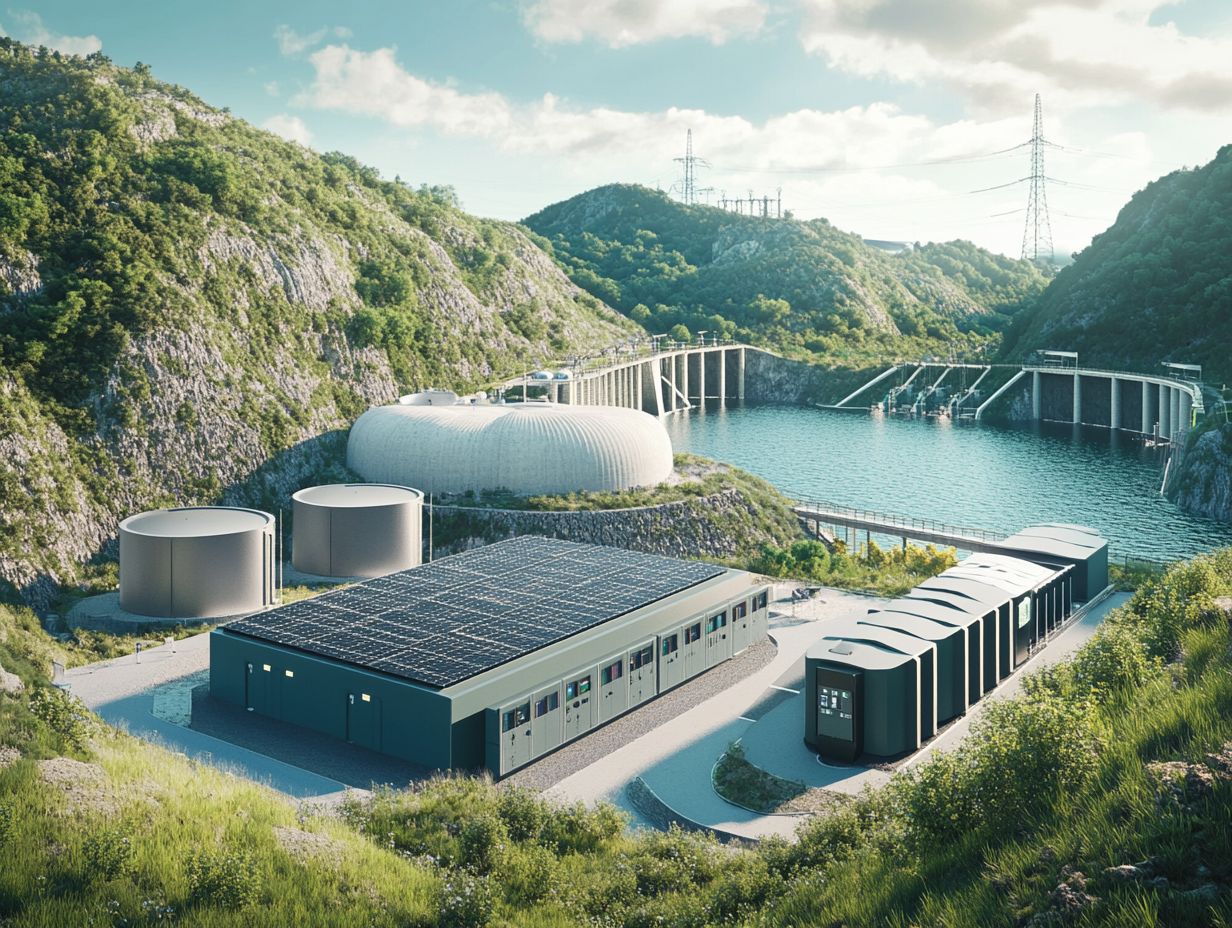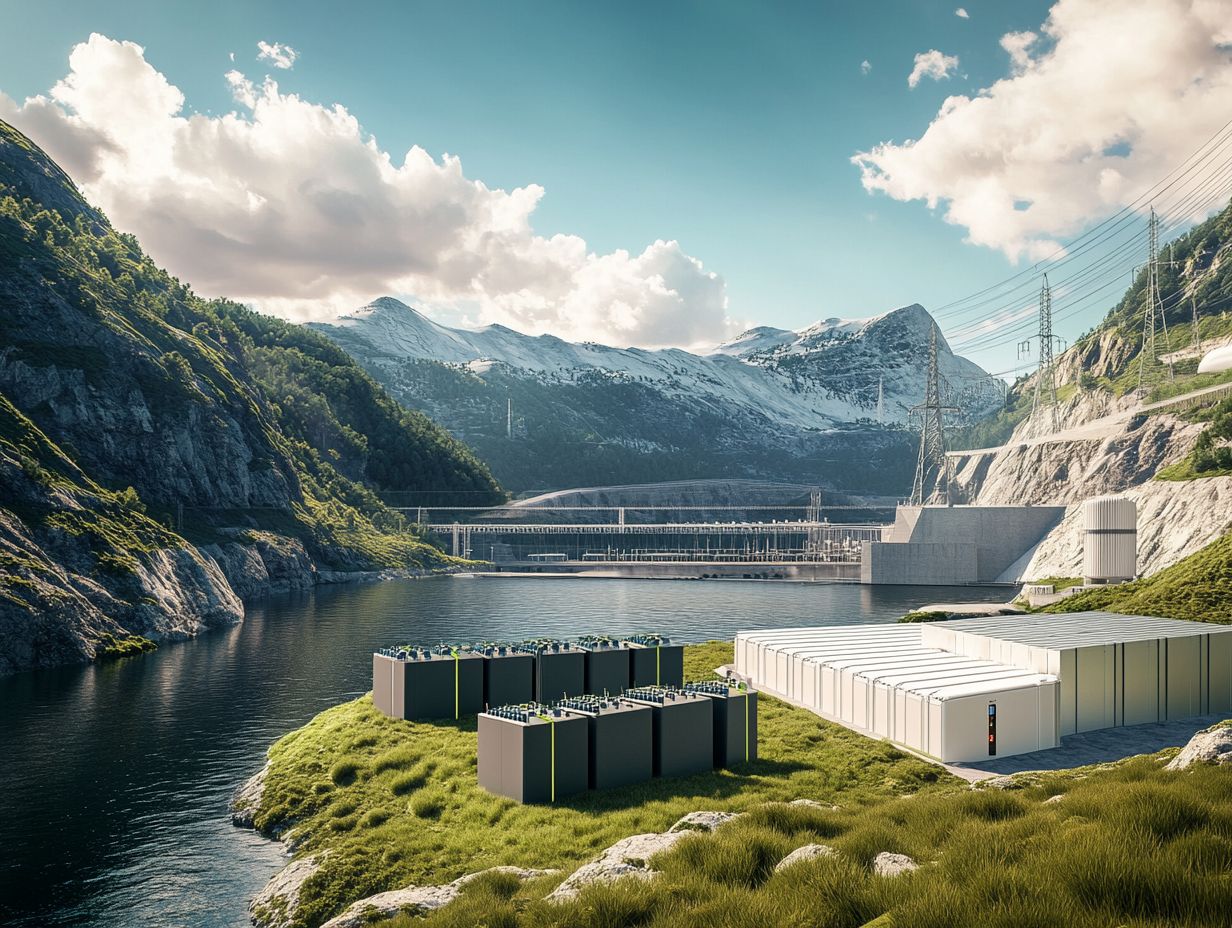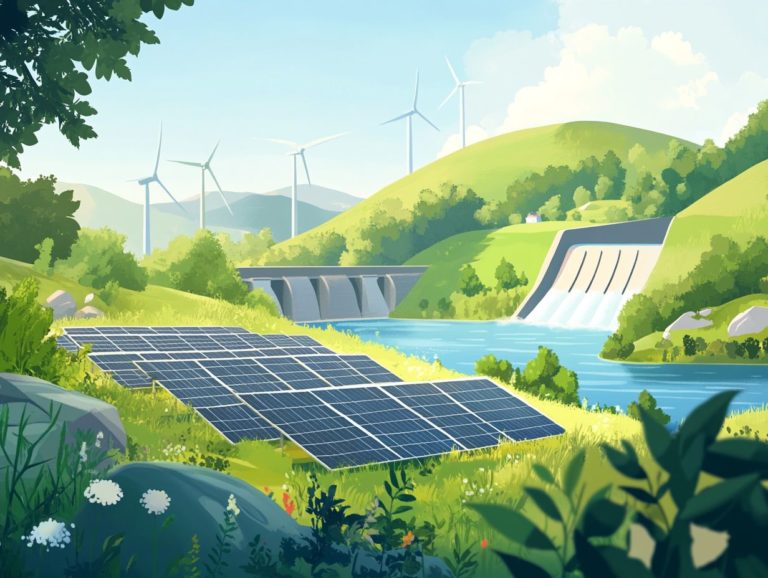How Do Energy Storage Systems Work?
Energy Storage Systems (ESS), including advanced battery energy storage solutions, are crucial in your journey toward a more sustainable energy future.
You’ll find a range of technologies, from batteries to pumped hydro, all working to efficiently harness and store energy.
Ready to explore how these systems work? This article dives into the various types of energy storage systems, including lithium-ion batteries and pumped hydro technologies. We will explore how they operate, the multitude of benefits they offer, and the challenges that stand in the way of their widespread adoption.
Discover now how these systems are transforming energy management!
Contents
- Key Takeaways:
- Types of Energy Storage Systems
- How Energy Storage Systems Work
- Benefits of Energy Storage Systems
- Challenges and Limitations
- Frequently Asked Questions
- How do energy storage systems work?
- What are the benefits of using energy storage systems?
- What types of energy storage systems are available?
- How are energy storage systems used in homes and buildings, especially in the context of renewable energy technologies?
- Do energy storage systems have any environmental benefits?
- Are there any downsides to using energy storage systems?
Key Takeaways:

- Energy storage systems allow for the storage of excess energy generated from renewable sources, such as solar energy and wind power. This provides a constant energy supply and reduces reliance on traditional fossil fuels.
- There are various types of energy storage systems, including batteries, pumped hydro, compressed air, and thermal storage, each with its own unique technology and application.
- These systems work by converting and storing energy in a form that can be released on demand, providing a reliable and flexible source of energy for both individuals and society as a whole.
What are Energy Storage Systems?
Energy Storage Systems (ESS) are essential elements in modern energy management, expertly designed to capture, store, and release energy as needed. This capability significantly enhances the efficiency of both energy production and consumption.
These innovative systems are particularly crucial in the context of renewable energy sources. They facilitate the transition to greener technologies, such as solar and wind, which can often be intermittent. By allowing you to store excess energy generated during peak production times for later use, they help stabilize energy supply and mitigate fluctuations, as explained in understanding energy storage.
With advancements in battery technologies like solid-state and flow batteries, more efficient and longer-lasting storage solutions are on the horizon. As electric vehicles continue to rise in popularity, understanding how energy storage supports grid stability becomes even more vital.
These systems play a key role in reducing energy costs and optimizing energy usage across various sectors, including residential, commercial, and industrial applications. To understand how these systems work, exploring the science behind energy storage technologies is essential. Ultimately, this fosters a more resilient and sustainable energy future for all.
Types of Energy Storage Systems
You will discover various types of energy storage systems, each employing distinct technologies and methods to effectively store energy for future use. These systems play a crucial role in efficiently managing energy demand and supply, ensuring a balanced and reliable energy landscape.
Overview of Different Technologies
Different technologies in energy storage systems, such as battery storage, pumped hydro, and compressed air energy storage, each bring their own distinct advantages tailored to meet specific energy needs.
These systems are vital in today’s energy landscape, providing the flexibility and reliability essential for a stable energy supply. For example, battery storage allows for rapid response times and can be easily scaled, making it perfect for urban settings where energy consumption fluctuates throughout the day. Understanding how to implement energy storage in your home can further enhance your energy management strategies.
On the other hand, pumped hydro harnesses energy stored due to an object s position in a gravitational field, enabling substantial energy storage capacity over extended periods. This is crucial for balancing supply and demand in large-scale power grids.
Compressed air energy storage takes a different approach by using high-pressure air to store energy efficiently, presenting a smart solution for managing the variability of renewable sources like wind and solar.
By grasping the nuances of these various technologies, you can strategically leverage energy systems to optimize performance and learn how to integrate energy storage with solar panels to address the growing demands for energy.
How Energy Storage Systems Work

Energy Storage Systems function on core principles of converting and storing energy, whether through the chemical reactions in lithium-ion batteries or the physical mechanisms in pumped hydro systems. This ensures you have a reliable electricity supply precisely when you need it.
Basic Principles and Processes
The fundamental principles of energy storage technology focus on converting electrical energy into a storable form. A range of processes is designed for efficient energy management.
These processes encompass charging, where energy is gathered for future use, and discharging, which allows for the release of stored energy during peak demand. Understanding how to choose the right energy storage system is crucial as energy conversion techniques are vital in tailoring energy for various applications, ensuring compatibility with diverse systems.
By understanding these processes, you can appreciate their role in optimizing energy systems. This knowledge leads to improved management strategies that effectively address demand fluctuations, enhance grid stability, and support the integration of renewable sources.
This multi-faceted approach fosters sustainable energy practices and paves the way for a resilient future in energy consumption.
Benefits of Energy Storage Systems
Energy storage systems offer incredible advantages that can transform your daily life! These benefits extend beyond personal gains to include societal gains that enhance community resilience, reduce energy costs, and foster a more sustainable energy supply.
Advantages for Individuals and Society
For you, the benefits of energy storage systems are substantial. They offer reduced energy costs and enhanced management of your energy use. This control allows you to tailor your electricity supply effectively.
Imagine storing the excess energy you generate during peak sunlight hours. This capability can lead to significant savings on your electricity bills. By optimizing your energy consumption during high-demand periods, you can contribute to a more balanced grid and alleviate pressure on existing infrastructure. For a deeper understanding of how this works, check out energy storage systems: a complete guide.
As society shifts toward renewable energy sources, the importance of these storage solutions cannot be overstated. They help address the inconsistent energy supply often associated with solar and wind power. To understand the financial aspect, it’s crucial to know how much home energy storage systems cost, ensuring a reliable supply for everyone.
Ultimately, investing in energy storage not only offers economic advantages for you but also strengthens community resilience. This paves the way for a more sustainable future that benefits us all.
Challenges and Limitations

Despite their many advantages, energy storage systems face challenges and limitations that hinder their adoption and integration into existing energy frameworks.
Obstacles to Widespread Adoption
The journey toward the widespread adoption of energy storage systems is often obstructed by high upfront costs, regulatory challenges, and concerns about their environmental impact.
These hurdles create a complex landscape that may deter you, whether as an investor or an innovator, from entering the market. Socio-economic factors, like income disparity and regional energy accessibility, intensify these issues, making it challenging for certain communities to adopt new technologies.
Navigating rules and regulations that govern energy storage can feel like wading through a maze. Varying standards and incentives across jurisdictions lead to confusion and inconsistencies in implementation. Additionally, environmental concerns regarding the sourcing and disposal of materials used in energy storage systems raise critical questions about their long-term sustainability. For a deeper understanding, exploring the history of energy storage technologies can provide valuable insights.
Energy partnerships have emerged as a vital strategy to tackle these barriers, promoting collaboration among stakeholders to develop comprehensive solutions that benefit all.
Frequently Asked Questions
How do energy storage systems work?
Energy storage systems store excess energy produced from renewable sources, like solar or wind, for later use. This allows for a more consistent and reliable energy supply, even when the sun isn’t shining or the wind isn’t blowing.
What are the benefits of using energy storage systems?

Energy storage systems, including various battery technologies, help reduce energy costs and increase efficiency.
They also improve grid stability and offer clean energy alternatives. Furthermore, they reduce reliance on fossil fuels and promote renewable energy sources.
What types of energy storage systems are available?
Several types of energy storage systems are available, including batteries, flywheels, and pumped hydropower.
Each type has its advantages and suits different applications.
How are energy storage systems used in homes and buildings, especially in the context of renewable energy technologies?
Energy storage systems in homes can store excess energy from solar panels for later use.
This reduces electricity bills and provides backup power during outages.
Do energy storage systems have any environmental benefits?
Yes, energy storage systems reduce reliance on fossil fuels that emit harmful pollutants.
They promote renewable energy, like solar and wind, reducing carbon emissions and protecting the environment.
Are there any downsides to using energy storage systems?
Energy storage systems have many benefits, but they can be costly to install and maintain.
Some types may have a limited lifespan and need replacement after several years.






